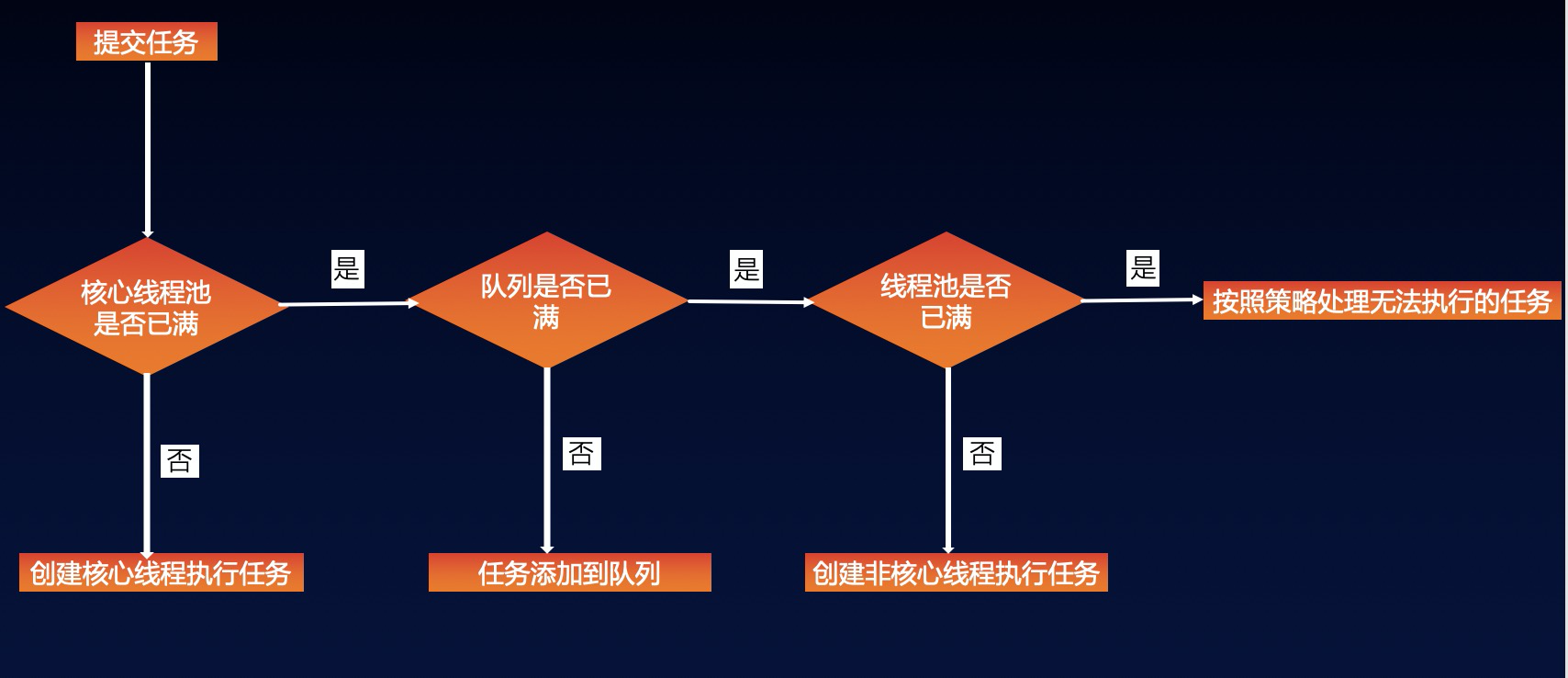线程池的基本原理?
为什么不用Executors创建线程池? 线程池不允许使用Executors去创建,而是通过ThreadPoolExecutor的方式,这样的处理方式让写的同学更加明确线程池的运行规则,规避资源耗尽的风险。 说明:Executors返回的线程池对象的弊端如下:
- FixedThreadPool和SingleThreadPool: 允许的请求队列长度为Integer.MAX_VALUE,可能会堆积大量的请求,从而导致OOM。
- CachedThreadPool: 允许的创建线程数量为Integer.MAX_VALUE,可能会创建大量的线程,从而导致OOM。
原理:

以上线程池的构造函数:
//允许的创建线程数量为Integer.MAX_VALUE,可能会创建大量的线程,从而导致OOM。
public static ExecutorService newCachedThreadPool() {
return new ThreadPoolExecutor(0, Integer.MAX_VALUE,
60L, TimeUnit.SECONDS,
new SynchronousQueue<Runnable>());
}
//允许的请求队列长度为Integer.MAX_VALUE,可能会堆积大量的请求,从而导致OOM。
public static ExecutorService newSingleThreadExecutor() {
return new FinalizableDelegatedExecutorService
(new ThreadPoolExecutor(1, 1,
0L, TimeUnit.MILLISECONDS,
new LinkedBlockingQueue<Runnable>()));
}
public static ExecutorService newFixedThreadPool(int nThreads) {
return new ThreadPoolExecutor(nThreads, nThreads,
0L, TimeUnit.MILLISECONDS,
new LinkedBlockingQueue<Runnable>());
}
//队列构造函数
public LinkedBlockingQueue() {
this(Integer.MAX_VALUE);
}
线程池创建的正确打开方式?
//org.apache.commons.lang3.concurrent.BasicThreadFactory
ScheduledExecutorService executorService = new ScheduledThreadPoolExecutor(1,
new BasicThreadFactory.Builder().namingPattern("example-schedule-pool-%d").daemon(true).build());
//Positive example 2:
ThreadFactory namedThreadFactory = new ThreadFactory() {
private AtomicInteger count = new AtomicInteger(0);
@Override
public Thread newThread(Runnable r) {
Thread t = new Thread(r);
String threadName = "Thread"+count.addAndGet(1);
t.setName(threadName);
return t;
}
};
//Common Thread Pool
ExecutorService pool = new ThreadPoolExecutor(5, 200,
0L, TimeUnit.MILLISECONDS,
new LinkedBlockingQueue<Runnable>(1024), namedThreadFactory, new ThreadPoolExecutor.AbortPolicy());
如何限定线程池数量?
CPU密集型 => 线程池的大小推荐为CPU数量 + 1,CPU数量可以根据Runtime.availableProcessors方法获取
O密集型 => CPU数量 * CPU利用率 * (1 + 线程等待时间/线程CPU时间)
混合型 => 将任务分为CPU密集型和IO密集型,然后分别使用不同的线程池去处理,从而使每个线程池可以根据各自的工作负载来调整
阻塞队列 => 推荐使用有界队列,有界队列有助于避免资源耗尽的情况发生
execute/submit线程池创建的两种方式
execute的实现,解答了线程池线程重复使用的问题,execute/submit本质上查不到,submit是包了FutureTask实现的
为什么说core线程不会被回收?core线程的复用机制?
final void runWorker(Worker w) {
Thread wt = Thread.currentThread();
Runnable task = w.firstTask;
w.firstTask = null;
w.unlock(); // allow interrupts
boolean completedAbruptly = true;
try {
//关键在这个getTask(),进行了线程阻塞循环
while (task != null || (task = getTask()) != null) {
w.lock();
// If pool is stopping, ensure thread is interrupted;
// if not, ensure thread is not interrupted. This
// requires a recheck in second case to deal with
// shutdownNow race while clearing interrupt
if ((runStateAtLeast(ctl.get(), STOP) ||
(Thread.interrupted() &&
runStateAtLeast(ctl.get(), STOP))) &&
!wt.isInterrupted())
wt.interrupt();
try {
beforeExecute(wt, task);
Throwable thrown = null;
try {
task.run();
} catch (RuntimeException x) {
thrown = x; throw x;
} catch (Error x) {
thrown = x; throw x;
} catch (Throwable x) {
thrown = x; throw new Error(x);
} finally {
afterExecute(task, thrown);
}
} finally {
task = null;
w.completedTasks++;
w.unlock();
}
}
completedAbruptly = false;
} finally {
processWorkerExit(w, completedAbruptly);
}
}
private Runnable getTask() {
boolean timedOut = false; // Did the last poll() time out?
for (;;) {
int c = ctl.get();
int rs = runStateOf(c);
// Check if queue empty only if necessary.
if (rs >= SHUTDOWN && (rs >= STOP || workQueue.isEmpty())) {
decrementWorkerCount();
return null;
}
int wc = workerCountOf(c);
// Are workers subject to culling?
boolean timed = allowCoreThreadTimeOut || wc > corePoolSize;
if ((wc > maximumPoolSize || (timed && timedOut))
&& (wc > 1 || workQueue.isEmpty())) {
if (compareAndDecrementWorkerCount(c))
return null;
continue;
}
try {
//注意这里的take方法
Runnable r = timed ?
workQueue.poll(keepAliveTime, TimeUnit.NANOSECONDS) :
workQueue.take();
if (r != null)
return r;
timedOut = true;
} catch (InterruptedException retry) {
timedOut = false;
}
}
}
/**
* Retrieves and removes the head of this queue, waiting!!! if necessary
* 感兴趣可以看看take的实现,是不断循环阻塞的一个方法
* until an element becomes available.
*
* @return the head of this queue
* @throws InterruptedException if interrupted while waiting
*/
E take() throws InterruptedException;
拒绝机制的手操
拒绝策略 => 默认采用的是AbortPolicy拒绝策略,直接在程序中抛出RejectedExecutionException异常【因为是运行时异常,不强制catch】,这种处理方式不够优雅。处理拒绝策略有以下几种比较推荐:
在程序中捕获RejectedExecutionException异常,在捕获异常中对任务进行处理。针对默认拒绝策略;
使用CallerRunsPolicy拒绝策略,该策略会将任务交给调用execute的线程执行【一般为主线程】,此时主线程将在一段时间内不能提交任何任务,从而使工作线程处理正在执行的任务。此时提交的线程将被保存在TCP队列中,TCP队列满将会影响客户端,这是一种平缓的性能降低;
自定义拒绝策略,只需要实现RejectedExecutionHandler接口即可;
如果任务不是特别重要,使用DiscardPolicy和DiscardOldestPolicy拒绝策略将任务丢弃也是可以的。
当然,如果使用Executors的静态方法创建ThreadPoolExecutor对象,考虑使用Semaphore对任务的执行进行限流也可以避免出现OOM异常